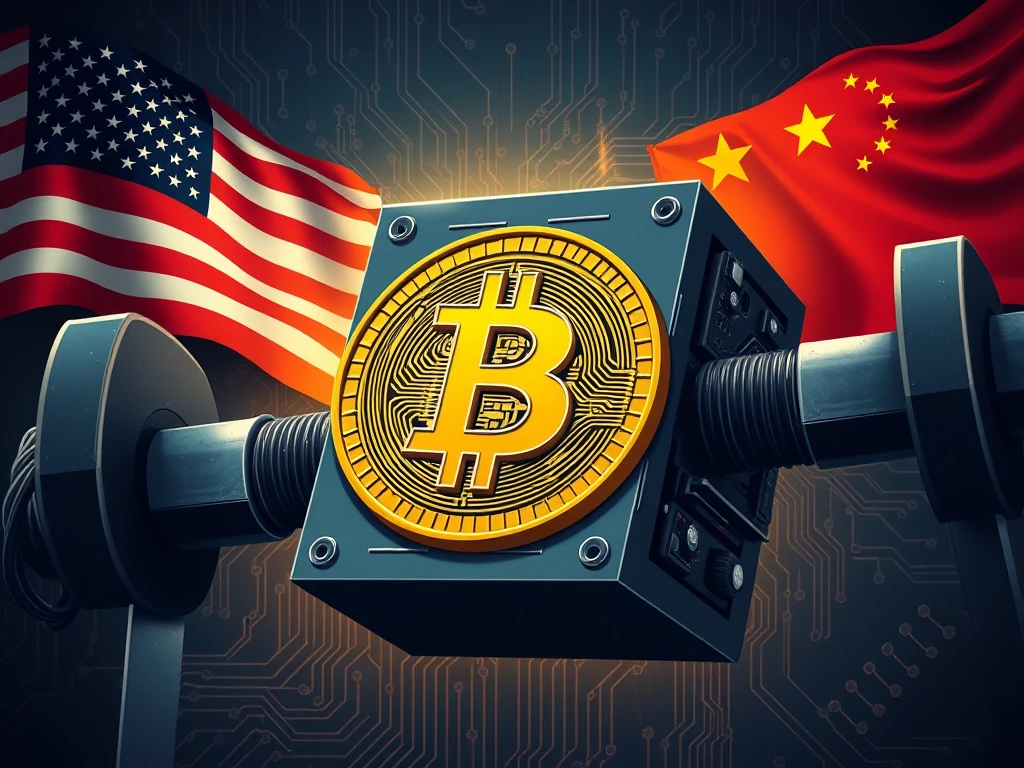Urgent Warning: Trump Tariffs Crush Bitcoin Miners Amid Chip Manufacturing Crisis

Are Bitcoin miners facing an unprecedented crisis? President Trump’s latest tariffs are adding immense pressure to an already struggling Bitcoin mining industry. Experts are sounding the alarm, warning that these new economic policies could have devastating consequences for both US and global Bitcoin mining operations. Let’s dive into how Trump tariffs are impacting Bitcoin miners and what the future holds for this vital sector of the crypto economy.
Trump Tariffs: A New Blow to Bitcoin Mining
The recent announcement of new trade tariffs by the Trump administration has sent ripples of concern throughout the Bitcoin mining community. These tariffs, imposing a 10% levy on all imports to the US and targeting key trading partners with ‘reciprocal’ measures, are poised to exacerbate the existing challenges faced by Bitcoin miners worldwide. While the debate continues on the broader economic impacts, one thing is clear: the Bitcoin mining industry is feeling the squeeze.
Hashprice Hits Rock Bottom: Miners Already Under Pressure
Before these new tariffs even came into play, Bitcoin miners were already navigating a tough landscape. A key indicator of miner profitability, the hashprice, has been in a persistent decline since 2022. In 2024, it plummeted to record lows, hitting $50 for the first time. As of late March, data from Bitbo showed hashprice still lingering around a meager $53.
Consider these factors contributing to the already strained profitability:
- Decreasing Hashprice: Miners are earning less revenue per unit of computing power.
- Rising Operational Costs: Energy prices and maintenance expenses remain significant.
- Increased Competition: The Bitcoin network’s hashrate continues to grow, making mining more competitive.
Kristian Csepcsar, chief marketing officer at Braiins, a Bitcoin mining technology provider, emphasizes the critical role of hashprice: “Hashprice is the key metric miners follow to understand their bottom line. It is how many dollars one terahash makes a day. A key profitability metric, and it is at all-time lows, ever.”
Mining Equipment Tariffs: Double Trouble for US Miners
The tariffs aren’t entirely new. According to Csepcsar, mining equipment tariffs were already on the rise under the Biden administration in 2024. Summer Meng, general manager at Bitmars, a Chinese crypto mining supplier, has also noted this trend. However, Csepcsar points out a significant escalation: “But they keep getting stricter under Trump.”
The latest measures are particularly concerning. For Chinese mining imports, including giants like Bitmain – the world’s largest ASIC manufacturer – Trump’s tariffs add a staggering 34% on top of an existing 20% levy. This means a total tariff burden of 54% on crucial mining equipment from a major supplier.
Chip Manufacturing Bottleneck: A Decade to Catch Up?
The pain doesn’t stop there. Cutting-edge chips essential for Bitcoin mining are predominantly manufactured in Taiwan and South Korea. These nations are also in the crosshairs of Trump’s new tariffs, facing levies of 32% and 25%, respectively. This hits American Bitcoin miners especially hard, as they rely on these international supply chains for advanced chip manufacturing.
Csepcsar highlights the long-term implications: “It will take a decade for the US to catch up with cutting-edge chip manufacturing. So again, companies, including American ones, lose in the short term.” The US simply lacks the domestic infrastructure to immediately replace these crucial chip sources, leaving American miners vulnerable and less competitive.
Who Benefits? Shifting Hashrate Dominance
While US and potentially global mining operations struggle under tariff pressure, some regions might see a boom. Csepcsar notes that countries within the Commonwealth of Independent States (CIS), such as Russia and Kazakhstan, are increasing their mining activities. These regions often boast:
- Lower Tariffs: Less impacted by global trade disputes.
- Favorable Mining Conditions: Access to cheaper energy and suitable climates.
“If we continue to see trade war, these regions with low tariffs and more favorable mining conditions can see a major boom,” Csepcsar warns. This could lead to a significant shift in global hashrate distribution, potentially diminishing the US’s role in Bitcoin mining and hindering Trump’s ambition to make the US a global leader in the sector.
Trump’s Crypto Stance: A Confusing Path Forward
President Trump’s stance on crypto has been anything but consistent. While his administration has recently shown signs of embracing a more pro-crypto agenda, these new tariffs create a perplexing contradiction. How can the US become a Bitcoin mining leader while simultaneously implementing economic policies that directly harm its domestic mining industry?
The long-term impact of these Trump tariffs on the crypto landscape remains uncertain. Will these policies ultimately undermine his pro-crypto goals? Or will there be strategic adjustments to mitigate the negative effects on Bitcoin miners? The coming months will be crucial in determining the trajectory of US Bitcoin mining under these new economic pressures.
The Bottom Line: Navigating the Tariff Terrain
Trump tariffs are undoubtedly adding significant headwinds for Bitcoin miners, compounding existing challenges like low hashprice and increasing operational costs. The reliance on foreign chip manufacturing further amplifies the impact, potentially hindering the growth of the US Bitcoin mining industry and shifting global hashrate dominance. Miners must now brace for a period of increased economic pressure and strategically navigate this evolving regulatory and economic landscape to ensure their survival and future prosperity.









